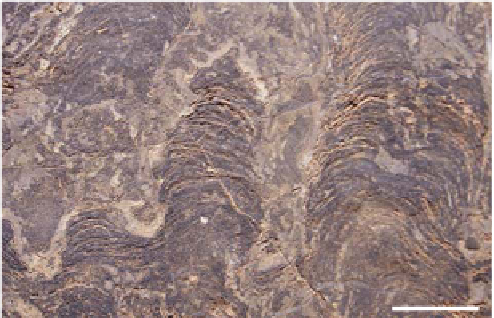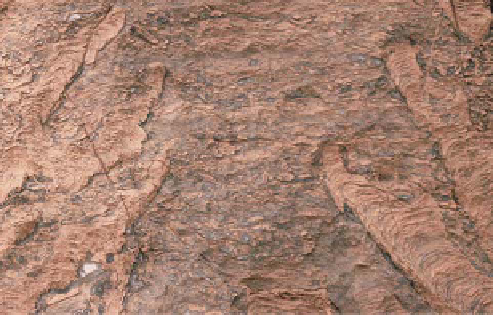Geology Reference
In-Depth Information
(a)
(b)
3 cm
(c)
(d)
3 cm
Fig. 8.
Branching columnar stromatolites of the Atar Formation. (a)
Tilemsina divergens
is characterized by low synoptic
relief, irregular margins and repeated outward-diverging branching. (b) Irregular branching and upward-broadening col-
umns of
Tungussia confusa
.
Tungussia
occurs primarily as small biostromes in inter-reef shales. (c) Strongly clustered,
irregular branching of
Baicalia
in the uppermost R3 reef interval. (d) Irregular branching columns of moderate synoptic
relief are represented in the Atar Formation by
Baicalia safi a,
which preserves irregular coniform laminae, and
Baicalia
mauritania
(shown here), which preserves domal laminae in cross-section.
This unusual mode of crystal growth is most
prevalent as a seafl oor precipitate in the Archaean
and as a void-fi lling cavity cement in younger
successions (de Wet
et al.
, 1999), and has been
attributed to both the presence of ferrous iron
under conditions of regional anoxia (Sumner &
Grotzinger, 1996b) and to the presence of locally
elevated concentrations of dissolved inorganic
carbon derived from remineralized organic matter
(Tourre & Sumner, 2000). In the Mesoproterozoic,
extensive precipitation of herringbone carbonate
is generally restricted to basinal facies (Kah
et al.
,
1999b), with its presence in platform deposits
closely associated with transgressive surfaces
(Kah
et al.
, 2006). Later stage void-fi ll typically
includes a single layer of isopachous bladed cal-
cite, coarse blocky calcite spar and ferroan dolo-
mite cement (Fig. 9a-d).
PARASEQUENCE DEVELOPMENT OF
STROMATOLITE BIOSTROMES
Superpositional relationships between and
among reef elements can be used to determine
the relative timing of deposition (or growth) of
elements, as well as the morphology of the sedi-
mentary substrate. Combined, these relationships
permit a detailed evaluation of changes in accom-
modation space during development of the Atar
Formation biostromes. The cratonal deposition
regime represented by the Atar Formation bio-
stromes, and the Atar Group as a whole (Bertrand-
Sarfati & Moussine-Pouchkine, 1988), suggests
that changes in accommodation space were
most likely driven by changes in sea level. In terms
of stromatolite development, sea-level changes
would result primarily in changes in ambient





